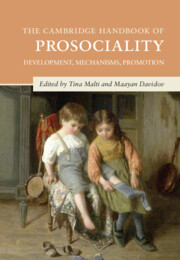Book contents
- The Cambridge Handbook of Prosociality
- Cambridge Handbooks in Psychology
- The Cambridge Handbook of Prosociality
- Copyright page
- Dedication
- Contents
- Figures
- Contributors
- Part I Development of Prosociality
- Part II Antecedents and Mechanisms of Prosociality
- Part III Development of Prosociality in Context
- Part IV Applications
- 26 Fostering Prosociality in the Family Context
- 27 Prosociality and Civic Engagement
- 28 Prosocial Behavior, Positive Youth Development, and Character Virtues
- 29 Relational Practices of Care to Nurture Prosociality and Advance Policy
- 30 Toward a New Era of Prosociality Research
- Afterword
- Index
- References
30 - Toward a New Era of Prosociality Research
Priorities, Challenges, and Possibilities
from Part IV - Applications
Published online by Cambridge University Press: 25 May 2023
- The Cambridge Handbook of Prosociality
- Cambridge Handbooks in Psychology
- The Cambridge Handbook of Prosociality
- Copyright page
- Dedication
- Contents
- Figures
- Contributors
- Part I Development of Prosociality
- Part II Antecedents and Mechanisms of Prosociality
- Part III Development of Prosociality in Context
- Part IV Applications
- 26 Fostering Prosociality in the Family Context
- 27 Prosociality and Civic Engagement
- 28 Prosocial Behavior, Positive Youth Development, and Character Virtues
- 29 Relational Practices of Care to Nurture Prosociality and Advance Policy
- 30 Toward a New Era of Prosociality Research
- Afterword
- Index
- References
Summary
This chapter outlines key foci for future research on prosociality and its development. It seeks to identify challenges and priorities and to delineate exciting possibilities for moving the field forward. These include the need for a useful taxonomy to help map the different dimensions and forms of prosociality across development; a call to extend the construct of prosociality by incorporating the perspectives of children and individuals from diverse cultures and backgrounds; the need to integrate knowledge from different levels of analysis; the notion that for a more complete understanding of prosociality in humans, both specificities and commonalities in processes of prosocial development must be addressed; and the need to understand major obstacles to prosocial development – how is it that, despite the human potential for prosociality, some individuals do not become prosocial? – and how to transcend such barriers. Addressing these issues, using rigorous and innovative work, will promote a new era of prosociality science.
Keywords
- Type
- Chapter
- Information
- The Cambridge Handbook of ProsocialityDevelopment, Mechanisms, Promotion, pp. 600 - 613Publisher: Cambridge University PressPrint publication year: 2023



